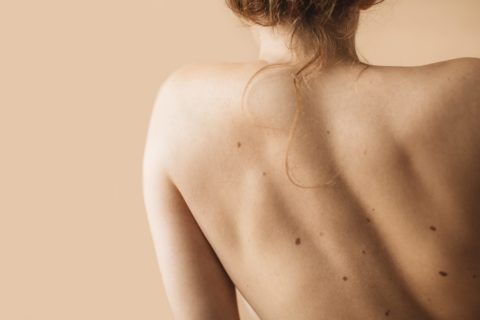Are Your Moles Normal? What You Need to Know and How to Check for Skin Cancer
By now most of us know better than to hit the tanning bed and we won’t leave home without a layer of sunscreen—even on cloudy days. But that doesn’t mean that we are free from concern about skin cancer. Even celebs aren’t safe: Back in 2016, Khloé Kardashian revealed that she had eight inches of skin removed because of a mole. (Luckily, it turned out to be benign.) She urged readers on her website to know their ABCDEs (more on that below).
The most serious form of skin cancer is melanoma, which is now the seventh most common cancer in Canada and the U.S. And in Canada, people born in the ’90s have a two to three times higher risk of getting skin cancer than those born in the ’60s. However, skin cancer has a high cure rate when found early, so here’s what you need to know.
The three most common types of skin cancer are basal cell carcinoma, squamous cell carcinoma and melanoma (the deadliest form). You can look out for them by performing a monthly body scan, during which you stand in front of a mirror, naked, and look closely at your skin from head to toe. To check the back of your body, use a mirror or ask your SO or BFF to help you (even check your scalp, ears, between your fingers and toes, and those areas where the sun don’t shine). Then, mark down the date and any moles/spots, noting the location, size, shape, borders and colour. Each month check back on them. If you notice any changes or new dots, make an appointment with your doctor.
Here are some of the common signs of skin cancer:
Basal cell carcinomas
Often found on areas exposed to the sun. It might look like a sore or a pimple and itch or bleed. It could also look like a shiny growth, a red patch or a scar-like spot.
Squamous cell carcinomas
This kind of skin cancer is also often found on sun-exposed areas but is more likely to spread if found on ears or lips. Look for a wart-like appearance, an open sore, a raised bump with a depression, or red, scaly skin.
Melanoma
This is the most dangerous form because it spreads quickly. A handy tool to check your skin is the “ugly duckling” test. Most moles look similar, so if one stands out from the pack it could be cause for concern.
You can also perform the ABCDE test to help determine if a spot could be melanoma. Here, a simple guide:
Asymmetry: Does one side look different than the other?
Border: Is the border irregular?
Colour: Are there multiple colours/shades in the mole?
Diameter: Is it larger than six millimetres (the size of a pencil eraser)?
Evolution: Has it changed? If you answer yes to any of these questions, have your doctor check it out.









